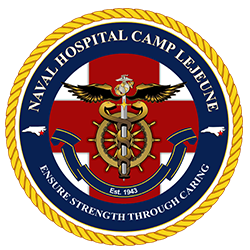Naval Medical Center Camp Lejeune
| Naval Hospital Camp Lejeune | |
|---|---|
| Onslow County, near Jacksonville, North Carolina | |
 MCB Camp Lejeune Insignia | |
| Type | Military hospital |
| Site information | |
| Controlled by | Bureau of Medicine and Surgery, United States Navy |
| Site history | |
| Built | 1943 |
| Garrison information | |
| Current commander | Captain James L. Hancock, Medical Corps, United States Navy[1] Captain Amy Bransetter, Medical Corps, United States Navy[2] CMDCM (SS/FMF/SW/AW) Graham P. Luby, United States Navy[3] |
| Past commanders | [4] |
Naval Hospital Camp Lejeune is a United States Navy-run facility that is located on Marine Corps Base Camp Lejeune in North Carolina, USA.
Its dedicated, multi-disciplinary health care team provides individualized and comprehensive care to all of its beneficiaries by using a combination of traditional medical services, alternative therapies, state-of-the-art technologies and modern drug therapy.
Residing on the largest military installation on the East coast, the hospital serves approximately 150,000 active duty military personnel, retirees and family members.
Its vision is to be your medical center of choice, and together, we, “Ensure Strength Through Caring!”
History
Out of a 144-acre area of swamp, sand dunes, and snakes grew Naval Hospital Camp Lejeune over sixty-four years ago.
With World War II already engulfing Europe, it became evident that facilities at Quantico and Parris Island were inadequate to meet Marine Corps plans for expansion on the east coast. After detailed reconnaissance, the vicinity of New River, North Carolina was determined to be the most suitable area for all elements of a Marine Division. On February 15, 1941 the Navy Department received approval to construct the East Coast Marine Corps Training Center that is now Camp Lejeune.

The peninsula known as Hadnot Point was selected as the site for the original Naval Hospital. Construction that began on March 13, 1942. By June, the first building was substantially complete and was turned over to Captain T. L. Morrow, MC USN, the Prospective Medical Officer in Command. On March 30, 1942, Chief Pharmacist V. M. Coulter, USN reported aboard and began preparing requisitions for the “several hundred thousand dollars” of medical equipment and supplies required to outfit the hospital. Captain J. F. Riordan, MC USN reported on May 14, 1942 to assume the duties as command officer.
The Naval Hospital Camp Lejeune was commissioned May 1, 1943.
Staff assigned to the hospital in May 1943 consisted of 51 Officers, 90 Navy Nurses, 270 Navy Corpsmen and 150 Civilian employees.
The hospital reached its highest patient load of 2,087 during WWII. Beds were placed in passageways and double-deck bunks were used extensively. During the Korean War, the peak census was about 1,865, including many Army patients suffering from frostbite injuries.
In July 1975 the current site was approved for construction of a new Naval Hospital. The contract for construction of the new hospital was finalized ground breaking took place in May 1979.
In a Mast Stepping ceremony on July 21, 1982, silver dollars were placed at the base of the new hospital’s flag poles. The placing of the coins, honoring the Chief of Naval Operations, the Commandant of the Marine Corps, and the Surgeon General, is taken from an ancient Roman custom. The tradition of placing coins at the foot of a ship’s mast was said to ensure that the fare of all hands on board was paid for passage across the River Styx.
The new hospital was built on a 162-acre site on the Northeast Creek at a cost of $46 million. In contrast to the old Hospital, the new hospital is a compact unit, consisting of a 4-story clinical and support building, with bed capacity at 205, expandable to 236. The surgical suite consisted of 5 operating rooms, and the Obstetrical Suite had 5 labor rooms and 3 delivery rooms. The cost to equip the new hospital was $8,200,000.00. Remarkably the move-in was accomplished in only two days from February 12 to 13, 1983.
The dedication ceremony was held on May 12, 1983. The new hospital did not get the benefit of enjoying peaceful times. The bombing of the Marine Barracks in Beirut, Lebanon in October 1983 was the first test of the new hospital’s ability to respond to such an emergency. Over 50 wounded marines were received at the hospital over the ensuing weeks.
When Iraq invaded the tiny Arab kingdom of Kuwait on August 2, 1990, the Naval Hospital was once again called upon to respond. Two hundred and forty-eight personnel from the Naval Hospital Camp Lejeune were deployed in support of “Operation Desert Storm.” Reporting on board to backfill and assist with casualty support were 412 Naval Reservists. The hospital received close to 400 Marines and Sailors evacuated from the Southwest Asia theater of operations.
Life at Naval Hospital was forever changed on September 11, 2001, with the terrorist attack on the Twin Towers of the World Trade Center and the Pentagon. In January 2002, Naval Hospital deployed 150 Doctors, Nurses and Corpsmen as Fleet Hospital 20, Joint Task Force 160 to Guantanamo Bay, Cuba to establish medical facilities for detainees from the developing war on Iraq and a Global War on Terrorism. The hospital saw more and more deployments in support of “Operation Enduring Freedom“ and “Operation Iraqi Freedom.”
In January 2005, Naval Hospital Camp Lejeune became the primary casualty receiving facility when II MEF became the predominant force in theater in continuing OIF, receiving about 30 casualties of war, a month. Currently, the hospital has deployed staff in Afghanistan, Kuwait, Cuba, and the Horn of Africa, and, the proud staff of Naval Hospital Camp Lejeune consists of approximately 240 Officers, 600 Sailors, over 1000 civilians and contractors, and our many dedicated volunteers.[5]
Notes
- ^ <http://www.med.navy.mil/sites/nhcl/Visitors/Pages/Leadership.aspx
- ^ <http://www.med.navy.mil/sites/nhcl/Visitors/Pages/Leadership.aspx
- ^ http://www.med.navy.mil/sites/nhcl/Visitors/Pages/Leadership.aspx
- ^ http://www.med.navy.mil/sites/nhcl/Visitors/Pages/ComInfo.aspx
- ^ "Command Information". www.med.navy.mil. Retrieved 2015-11-24.


